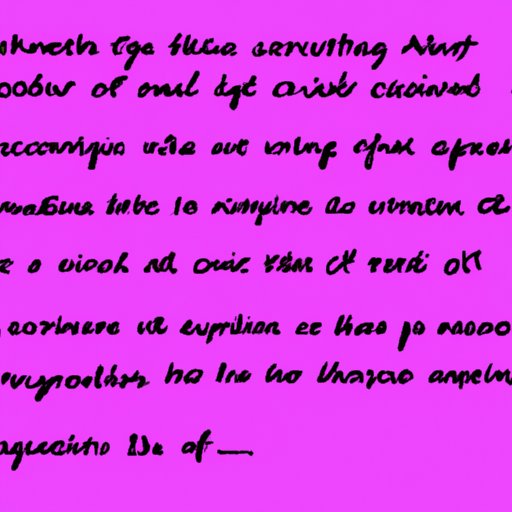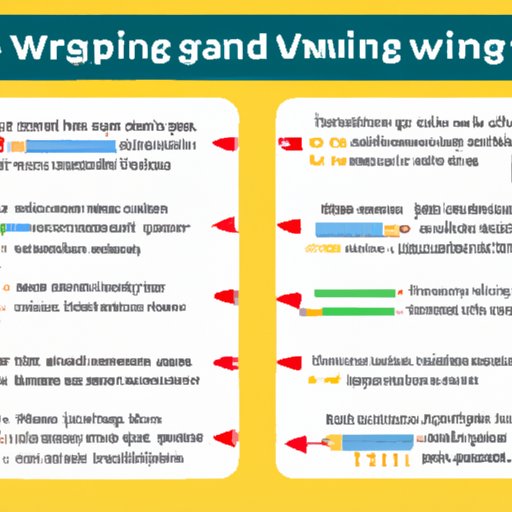Introduction
Writing is an essential skill that helps us communicate our thoughts, feelings, opinions, and ideas. Whether it’s for school, work, or personal reasons, the ability to write effectively is essential in our everyday lives. Teaching writing requires patience, practice, and knowledge of the fundamentals of writing. This article will provide an overview of how to teach writing, from brainstorming ideas to understanding grammar and punctuation.
Step-by-Step Guide to Creating Effective Writing Pieces
When teaching writing, it’s important to provide students with a step-by-step guide on how to create effective writing pieces. The following are the steps for creating an effective piece of writing:
Brainstorming Ideas
The first step in the writing process is brainstorming ideas. This involves coming up with creative and original ideas for the topic at hand. Brainstorming is an important step because it helps the writer narrow down their focus and develop a plan for their writing piece.
Outlining the Structure and Flow of the Piece
Once the writer has come up with some ideas, they can begin to outline the structure and flow of the piece. Outlining helps the writer organize their thoughts and ensure that their writing flows logically. During this step, the writer should consider the main points they want to make, the evidence they need to support these points, and the order in which they will present them.
Writing the First Draft
Once the outline is complete, the writer can begin drafting their piece. During this stage, the writer should focus on getting their thoughts down on paper without worrying too much about grammar or punctuation. The goal of this step is to get the content down, not to perfect every sentence.
Editing and Revising
After the first draft is complete, the writer should go back and edit and revise their work. This is the most important step in the writing process because it allows the writer to make sure their writing is clear and concise. During this step, the writer should check for grammar and spelling errors, improve the flow of their writing, and add any additional information they feel is necessary.

Examples of Successful Writing Pieces
To give students a better understanding of what a successful writing piece looks like, it’s helpful to provide examples of successful writing pieces. Examples of successful writing pieces include short stories, essays, and business reports. Each of these pieces requires its own unique approach and style, so it’s important to provide students with examples of each type of writing.

Tips and Advice on Improving Writing Skills
In addition to providing examples of successful writing pieces, it’s also important to provide students with tips and advice on how to improve their writing skills. Some helpful tips for improving writing skills include reading often, practicing writing daily, and using a grammar checker. These tips will help students become more confident in their writing abilities.

The Importance of Grammar and Punctuation
Grammar and punctuation are two of the most important elements of writing. It’s important to teach students the correct usage of grammar rules and the various types of punctuation marks. Knowing the basics of grammar and punctuation will help students craft more effective and articulate writing pieces.
Popular Writing Techniques and Styles
When teaching writing, it’s important to discuss popular writing techniques and styles. Some of the most common writing techniques and styles include descriptive writing, narrative writing, and persuasive writing. Understanding these techniques and styles will help students write more engaging and interesting pieces.
Different Types of Writing
In addition to discussing popular writing techniques and styles, it’s also important to discuss different types of writing. Different types of writing include creative writing, academic writing, and business writing. Each type of writing has its own set of rules and conventions, so it’s important to understand the differences between them.
Conclusion
Teaching writing can be a challenging but rewarding experience. By providing students with a step-by-step guide to creating effective writing pieces, offering examples of successful writing pieces, giving tips and advice on improving writing skills, understanding grammar and punctuation, and discussing popular writing techniques and styles, teachers can help their students become better writers. With patience, practice, and knowledge, teachers can help their students become skilled and confident writers.
(Note: Is this article not meeting your expectations? Do you have knowledge or insights to share? Unlock new opportunities and expand your reach by joining our authors team. Click Registration to join us and share your expertise with our readers.)
